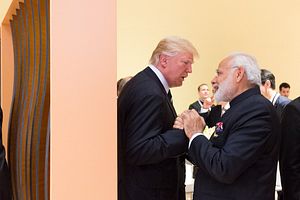India-U.S. relations have achieved yet another milestone with the recent renewal of triangular development cooperation in Asia and Africa. The first amendment to the Statement of Guiding Principles (SGP) was recently agreed on by the two nations, officially extending their partnership until 2021.
Triangular cooperation between the two partners and countries in Asia and Africa predates the conceptualization of the Indo-Pacific, with initial interests in development cooperation being reinforced in the 2016 Joint Statement during Indian Prime Minister Narendra Modi’s visit to the United States. In fact, it can be traced back to 2014 when India’s Ministry of External Affairs and the public diplomacy arm of the U.S. Agency for International Development (USAID) specifically agreed to jointly collaborate with other nations.. Development cooperation manifested itself in the form of particular capacity building programs. These programs are spread across various sectors including agriculture, trade and investment, health, and clean energy and others.
So far, one of the great successes of this partnership has been the Feed the Future- India Triangular Training Program – an initiative focused on training African agriculturalists in India while receiving aid and assistance from USAID. Other collaborations with African nations include the Agriculture Innovation Partnership, the Feed the Future India Africa Innovation Transfer Platform, Solar Conduction Dryer, Bullet Santi and Seed Dibbler, and the India-Kenya Dairy Innovation Bridge Program.
In Asia, too, the two nations have made laudable progress in implementing schemes ranging from women empowerment initiatives in Afghanistan, to programs like South Asia Regional Initiative for Energy Integration. The latter has helped promote cross-border electricity trade among South Asian countries as well as encouraging economic development in the region.
Moreover, USAID – in collaboration with Indian institutions – is providing capacity developing skills to countries like Nepal and Bhutan. Under the South Asia Regional Initiative for Energy Integration, India and U.S. have also been engaging in organizing workshops for the citizens of Nepal, Bhutan and other members of South Asia to help build capacity for designing, managing, and operating a power trading entity. Through programs like these, it is clear that the recent extension of the SGP agreement plays to the best interests of both India and the United States, as well as fortifying their mutual roles in the Indo-Pacific.
Through this cooperation, both India and the United States garner support from the citizens of the countries in which the development programs are being implemented. Such efforts could be seen as one of the major flagship program of India-U.S. joint collaboration in these countries. The primary objective of such public diplomacy initiatives is to create a positive narrative towards India-U.S. partnership in the larger Indo-Pacific region.
Aligning interests between the two will give impetus to their partnership, which was also reinforced through the recently passed Asia Reassurance Initiative Act by the Trump administration. India and U.S. relations have come a long way from the days of Cold War to the current strategic partnership that covers cooperative strategies across the spectrum from bilateral to multilateral formats, and from military to civilian aspects. The nature and the trajectory of the relationship has gone beyond the change of leaderships on both the sides. The India-U.S. partnership has been fostered by both Republicans and Democrats in the United States, and various governments in power in India for almost two decades now.
The emerging geopolitics of the Indo-Pacific region presents both challenges and prospects. On the one hand, there are great power politics at play in the region involving the rise of a militarily growing China and strategic responses to the same involving India and the United States. On the other hand, the Indo-Pacific region also presents opportunities for synergy between democracies like India and the United States to evolve a joint partnership to implement development projects in third countries. With ever-changing dynamics in the Indo-Pacific region, India and the United States both firmly believe in the maintenance of peace and stability in the region. Maintaining peace and stability in the region and efforts to preclude the rise of aggression and unilateral activities is a prerequisite for the purpose of inclusive and all-round development in the region of all regional partners to realize their national and regional objectives.
Analysts may have once indicated that the United States’ Indo-Pacific strategy lacked Indian involvement, but recent joint capacity-building suggests otherwise. New initiatives mark strong steps forward for the Indian Ocean region in increasing meaningful involvement in the Indo-Pacific. What remains now is even greater coordination between India and the United States.
Radhey Tambi is a post graduate research scholar in the Department of Geopolitics and International Relations, at Manipal Academy of Higher Education (MAHE) in Manipal, India.

































